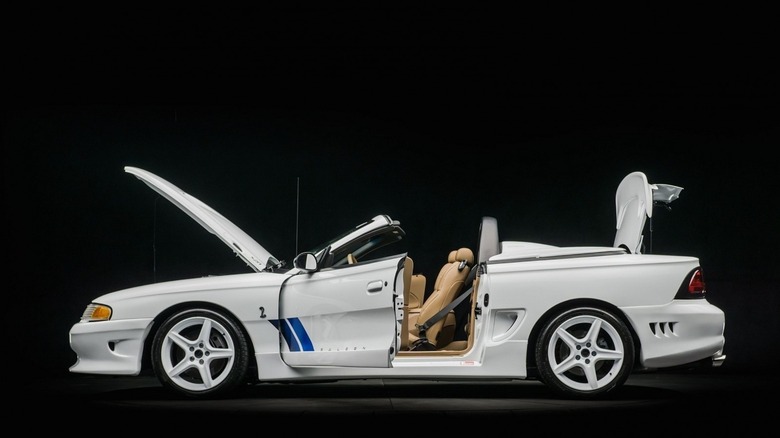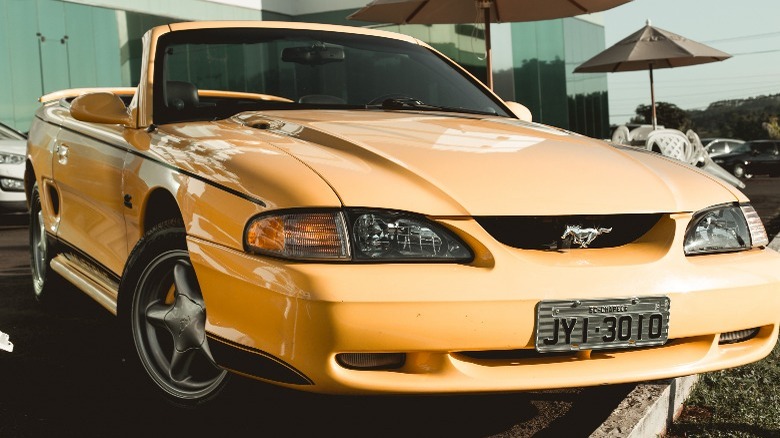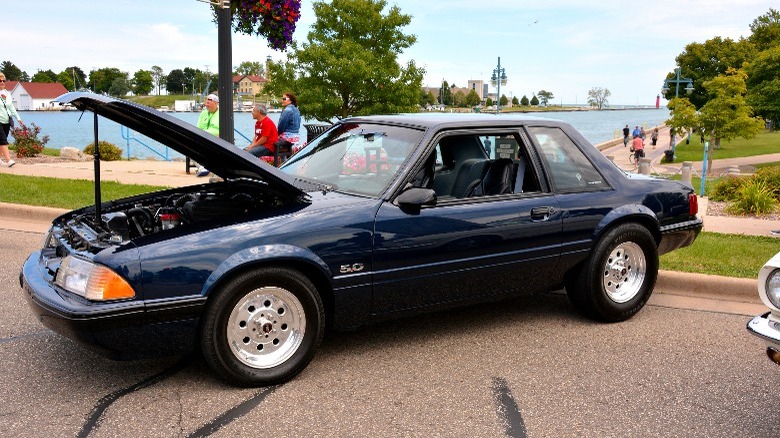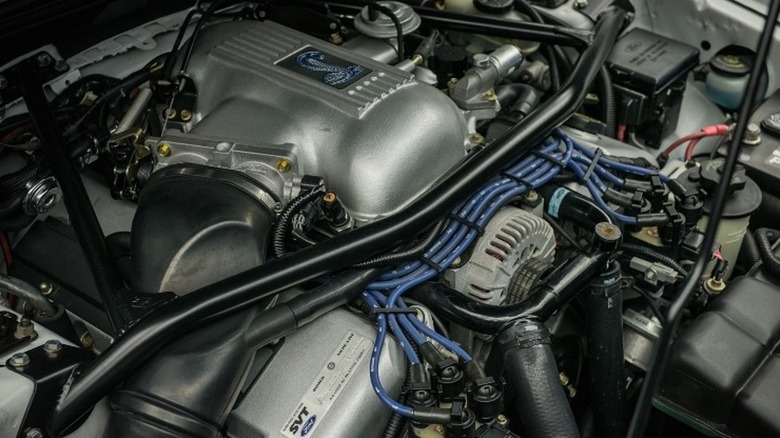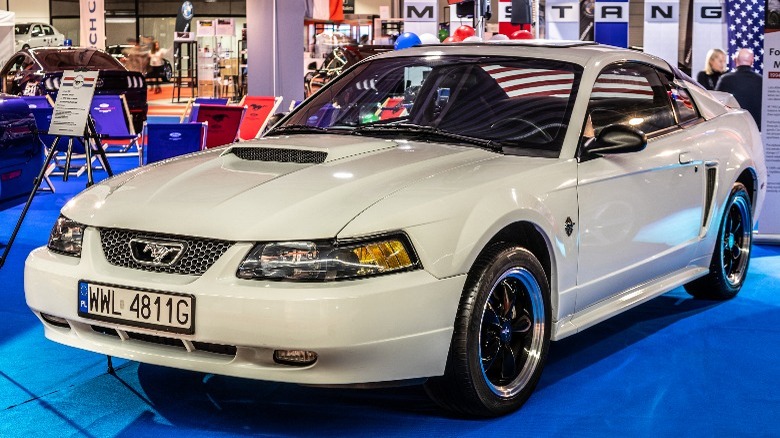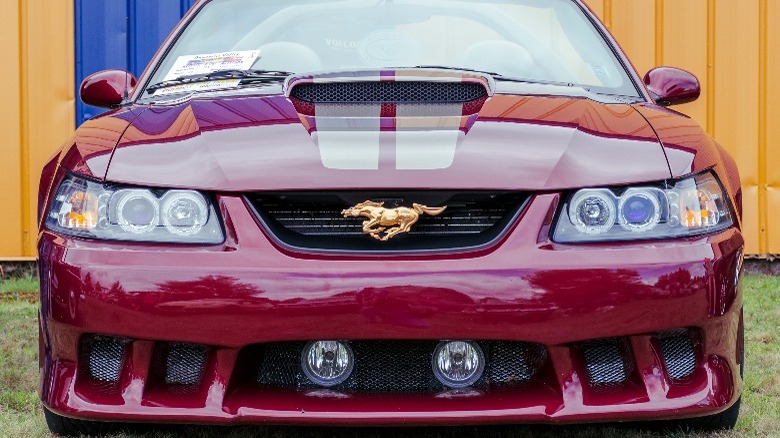Everything To Know About The SN95 Mustang
The Mustang, as we know it today, comes from a long and rich legacy spanning back to the early 1960s. This pony car's story is full of successes, including becoming one of Ford's most popular car models and receiving strong positive criticism across several Ford Mustang generations. One such generation that has served as a strong pillar in the Mustang's history is the SN95 Ford Mustang.
For those who don't know, the SN95 is the fourth-generation Mustang known for its distinctive Fox body style inherited from its third-generation predecessor but upgraded to a more modern and rounded design. While the SN95 Mustang was produced from 1994 to 2004, there are two classes of the SN95, which are divided by style and year of production. Ford did a redesign of its fourth-generation Mustang in 1999, resulting in the New Edge SN95, which has a different look from its older sibling.
Under the hood, the variety of SN95s featured a range of potent engines, including V6 and V8 options, with the GT and Cobra models being the most powerful and sought-after. The interior was upgraded for a more comfortable and ergonomic experience, reflecting the design trends of the '90s. The SN95 Mustang managed to blend the raw, muscular power that Mustangs are known for with a more contemporary and refined style, making it a beloved model among enthusiasts and a significant chapter in the Mustang's storied history.
The SN95 was almost a front-wheel drive
The historical context of the SN95 wasn't the most cheerful. In the mid-1980s, while Ford was contemplating its next-generation Mustang, gas prices were a major concern. The company, of course, knew that the need for fuel economy would affect sales of its car. Most Americans were opting for relatively more fuel-efficient front-wheel drives, and this prompted Ford to cook up an FWD plan. Ford had some stake in Mazda, and it used that as a partnership platform to plan for a front-wheel drive Mustang while still selling the Fox body as a "Mustang Classic," according to MotorTrend.
When the enthusiasts caught wind of this, there was a severe backlash, and they protested by bombarding Ford with letters. Eventually, Ford caved, but the motor company had already spent so much time and money on it and couldn't throw away the idea completely. Instead, they poured all of that into the Ford Probe, which didn't do better than the Mustang, thereby thwarting Ford's Mustang money-efficiency plans. The car returned to its American front-engine rear-wheel drive layout, which had made it such a favorite among car lovers.
Project SN95 was a rework of the third-gen Mustang
All the pushback against the FWD Mustang didn't come only from the enthusiasts outside of Ford; some of them came from inside. John Coletti, who was the program manager for the Mustang at the time, fought to have the car redesigned for the RWD.
Instead of launching a new Mustang, Ford green-lit the revamped project in 1989. It was codenamed SN95. The "S" means Small/Speciality Market, the "N" means that it was made for North America, and 95 follows the number for FMC's approved projects. The team, led by Coletti, set to work with a limited budget of only $700 million.
This relatively small budget forced the design team to get creative. Its solution was to reuse the Fox platform of the third-generation Mustang. That doesn't mean there weren't any comprehensive changes; in fact, around 80% of the third-gen's chassis was reworked and improved. It was then christened as the Fox 4. The thorough refresh of the previous generation's platform gave the SN95 more noise reduction and less of the rough vibrations common in the original Fox body.
The premier SN95 designs were named after popular celebrities
Ford was creating the new Mustang to be a performer, which was reflected in the team's design choices. The design director, Patrick Schiavone, wanted to make the car feel more aggressive. His design qturned some of the most characteristic Mustang features, like the tri-bar taillights, side C-scallops, and the galloping pony emblem.
After many trials, the design team developed three major templates: Arnold Schwarzenegger, John Rambo, and Bruce Jenner. Each of them was named to match. Like the character portrayed by Sylvester Stallone, Rambo was a lot more aggressive, with muscular edges, air intake contours, and a fastback-like look. The one that stuck was Arnold Schwarzenegger, which was considered a compromise between the conservative Jenner and the radical Rambo.
Ford released the first set of SN95 Mustangs in 1994 after making some edits to the Schwarzenegger design for better aerodynamics and cooling. It was an instant hit, and MotorTrend named it the 1994 Car of the Year.
What options did the SN95 come in?
Fresh off the lot, you could have gotten a base model SN95 with a V6 or a GT V8. Ford saved that precious dual overhead camshaft (DOHC) performance boost for the special editions. SN95s also only come as two-door coupes and convertibles, dumping the third option sedan layout.
The base model 1994 V6 option is a 3.8-liter "Essex" engine outputting 145 hp and 215 lb-ft of torque. The GT version, on the other hand, featured a pushrod 5.0-liter V8 engine that does 215 horsepower and 285 lb-ft of torque. Ford also launched an SVT Mustang Cobra in 1994 with a 5.0-liter engine with 240 horsepower and 285 lb-ft of torque.
When 1995 rolled around, Ford introduced a GTS version with the GT's powerplant but with the interior of a base model V6. The company also released 250 units of the SVT Cobra R in the same year, with a 5.8-liter V8 boasting 300 horsepower and 365 lb-ft of torque.
However, in 1996, Ford got rid of its V8 pushrod engine and replaced it with a modular 4.6-liter OHC engine. With the SOHC, the GT still retained its 215 horsepower and 285 lb-ft of torque. The SVT Cobra also got a modular 4.6-liter but with a DOHC that boosted it to 305 hp and 200 lb-ft of torque. But two years later, the GT upgraded to 225 horsepower and 290 lb-ft of torque.
All these options came in either a four-speed AOD-E automatic transmission or a T-5 five-speed manual transmission. Except for the Cobras — those got a more potent World Class T-5 manual transmission, and the exclusive 1995 Cobra R got a Tremec TR-3550 five-speed manual transmission.
Enter the New Edge Mustang
The SN95 saw a massive design revamp in 1999, when it adopted Ford's New Edge design language. Freelance journalist William Diem, who covered Ford's new design move for The New York Times in 1998, described this new look as "a combination of straight lines, curves, and planes." On the Mustang, this translated to more defined lines, angles, and crisper edges, making the car aggressive and meaner but attractive and modern.
While the interior didn't change much, the New Edge Mustang's exterior saw peculiar changes, like its new hood, which you could see with or without hood scoops. The headlights were also refreshed into a single-piece assembly. Along the sides, sharp lines and a faux side scoop echoed the aggressive front styling, a nod to the design of the older fourth-gen models. The rear also underwent a significant makeover, transitioning from a rounded to a boxier bumper and updating the taillights to the iconic tri-bar vertical rectangular layout.
Ford reserved the foglights on the grill exclusively for models other than the V6, and that didn't change for the New Edge. However, in celebration of the Mustang's 35th anniversary, both the V6 and GT Mustangs were adorned with a commemorative 35th-anniversary badge on the fender, marking a significant milestone in Mustang history.
The New Edge Ford Mustang options and specs
The New Edge Mustangs could almost pass for a new generation just because of how much change happened outside and inside the hood. Here's what the engine options looked like in each year:
-
1999: The base model V6 engine in these models can do 193 hp and 223 lb-ft of torque, reaching zero to 60 in 7.1 seconds. The 4.6-liter GT engines are rated at 260 hp with 302 lb-ft of torque, and these specs remain the same for every year until 2004. Meanwhile, the SVT Cobra for this year outputs 320 hp and 317 lb-ft of torque.
Advertisement -
2000: This year was exactly the same as the previous year — except there was no SVT Cobra. Instead, there was a special edition Cobra R with 385 hp and 385 lb-ft of torque. Since Ford sold only very limited numbers of this car, the Cobra R has now become a legendary vehicle that's worth a lot of money.
-
2001: The base model V6 got a three-hp jump and is now rated for 193 hp and 225 lb-ft of torque, and it remained the same till 2004. There's also an SVT Cobra with exactly the same specs as 1999. However, Ford released a 265 hp special edition Bullitt, based on the action movie of a similar name.
-
2003: The V8 SVT Cobra got an exciting supercharger this year, pumping up its horsepower to 390 and torque to 390 lb-ft. Ford also re-introduced the Mach 1, with a 305 hp Modular 4.6-liter engine doling 320 lb-ft of torque.
Advertisement -
2004: Ford ended the SN95's run with exactly the same lineup and specs as the previous year. Bringing an iconic series to an end.
